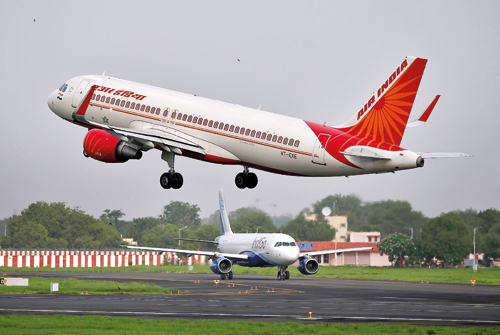Prodigal son, returned!
View(s):
File picture of an Air India plane - Reuters.
Apoorva (not her real name) was an employee of Air India and served for 20 years as an air hostess till mid-1990s. Then she bought an expensive apartment in a cosy area in Delhi. A relative asked her: “My gosh, it’s a miracle! How did you buy that apartment?”
Her response was that “it is from what I earned from my job”. In fact, it is not easy to buy a house from employment without a mortgage. The truth is, however, as she explained, when she worked for the airline she didn’t have to pay for her food, transport or rent. And all sort of things from cookies and drinks to chocolates and cutlery … almost all of them that she brought home were not her purchases either: They came from the airline as perks.
They also had business opportunities. The most preferred flights that they wish to serve were the West Asian and East Asian routes where they could buy electric and electronic items which are, then sold in bazaars in Indian cities. In the midst of import controls in India, these lucrative gadgets were all expensive luxury items that could be sold at high prices in Indian city bazaars.
The employees of Air India from top to bottom, were also entitled to free air tickets for the family every year for a vacation! Although most of these tickets are for the economy class, they hardly travel occupying economy class seats because they get it upgraded to the First Class or, at least Business Class!
It was not just the employees who looted Air India, but also the political authorities who had been entrusted with powers and responsibility. They did their part on a much bigger scale. They used to appoint their family members – uncles and aunties, sons and daughters, and in-laws to the key positions of the airline, even if they don’t have professional qualifications in the aviation field. They interfered with the daily affairs of the airline just to accommodate their own interests and those of their relatives and friends, causing losses in revenues and markets.
A former Minister of Aviation was accused for planning to buy 68 planes to the Air India fleet without any revenue plan or route map. He had also been accused of re-scheduling Air India flights for the benefit of a rival private airline – Kingfisher. Another had made Air India purchase his wife’s portraits as airline artwork by spending millions.
Liberalising the aviation sector
In the past few days, my friends from India – most of them are economists – had interesting issues related to a particular topic to talk about: The privatisation of Air India. All of my remarks mentioned above were extracted from the communication within this circle as well as from published media.
When the customers, in this case, air travel passengers, don’t have a choice due to government regulations, they must buy what is being offered. Before liberalising the aviation sector, it was a near monopoly of the government. As a result, irrespective of the quality and price of air travel service, the passengers had little choice outside Air India.
 As India began liberalising the aviation sector and adopting open sky policies, passengers benefitted through competition – more planes, improved quality, convenient connectivity, and cheaper tickets! Therefore, they have a choice now whether to fly with Air India or to choose another. However, aviation liberalisation didn’t change the fate of Air India, which continued to operate as a state-owned enterprise (SOE), but rather it began to multiply its losses.
As India began liberalising the aviation sector and adopting open sky policies, passengers benefitted through competition – more planes, improved quality, convenient connectivity, and cheaper tickets! Therefore, they have a choice now whether to fly with Air India or to choose another. However, aviation liberalisation didn’t change the fate of Air India, which continued to operate as a state-owned enterprise (SOE), but rather it began to multiply its losses.
Air India has many assets, including a fleet of more than 130 planes, thousands of trained pilots and crew members and, other workers. But as a typical case of a bleeding SOE, its accumulated losses amounted to US$9.5 billion. As the government announced, Air India has to add up $2.6 million losses every day! In addition, the airline also has unpaid bills amounting to over $2 billion, which is quite close to the sale price of the airline, $2.4 billion. All of the liabilities that are left with the government at the point of its sale will have to be paid ultimately by the taxpayers.
One good thing about the Indian economic policy making is that the political leadership knew that Air India cannot be run in the way it has been running with accumulating losses. The government tried even 20 years ago to sell it. It was in 2001 that the Indian government invited bidders to sell 40 percent of the stake of Air India, still keeping the controlling power. A number of reputed international airlines such as Lufthansa, British Airways and Singapore Airlines had shown interest, but they all stepped back due to a condition to partner with an Indian investor.
Snatching away the son
Prior to the present sale, there was an unsuccessful attempt in 2018 to sell a 76 percent stake of the airline with its controlling powers. Since 2014, the government was keen in bringing back its halted privatisation agenda. Finally, it was in January 2020 that the government made a clear decision either to sell it all or to close down, because “there is no choice”, according to the Aviation Minister.
Initially, Air India was a private airline set up by Tata group. It ran away from its father as the “prodigal son” or, rather it was snatched away by the government in 1953, as part of the then nationalisation programme. As import substitution policies were sweeping across the under-developed countries with its socialist bias towards the USSR, the nationalisation programme also came into being as an integral part of the new economic strategy.
After 68 years, with no more strength to survive any longer, somehow Air India found its way back home; it was the same Tata group which bought the airline. We hope, as my friends were talking about it too, that Air India will have a new lifeline to grow and to compete in the global aviation sector.
With higher growth of the economy and its intense global integration, India has also seen fast-growing air travel demand. Today, India is one of the fastest-growing economies in the world and it has also become one of
the most attractive destinations for foreign investment.
In this set up, future growth prospects for Air India in private hands remains bright. Together with this, it will also pose new challenges in the open sky in which South Asian and Southeast Asian airlines will have to face intense competition with Air India. Among these regional airlines, I presume that number one is SriLankan Airlines which is still a typical loss-making SOE that depends overwhelmingly on Indian routes.
Remnants of import substitution
Some of the developing countries, in spite of their policy reforms towards liberalisation, have been carrying forward their SOEs that were established during their import substitution regimes. India is still running 195 SOEs out of which only 11 enterprises have made decent profits recently. Compared with that Sri Lanka has around 400 SOEs. It is a common issue that SOEs make losses, while losses are shouldered by the public by paying taxes to maintain the SOEs.
It seems to be politically correct to keep the SOEs in the hands of the government because it has a multifaceted gain. It can bring the politicians to power because “non-privatisation policy” is politically attractive. It can allow the politicians to use the SOEs to fulfill their vested interests for which they appoint their own agents. The SOEs can also be used as employment agencies to provide jobs to the electorate.
Unlike in a private enterprise, there are multiple monitoring bodies for the SOEs such as the public, elected politicians, non-elected bureaucracy, and the management. But it is just the theory: Ultimately the question melts down to “who is accountable for what” on the one hand and “who bears the accumulating cost” on the other hand. Some would argue that “even though privatisation is good, it is corrupt too” but another would say that “one-time corruption is more tolerable than life-time looting”.
(The writer is a Professor of Economics at the University
of Colombo and can be reached at sirimal@econ.cmb.ac.lk and follow on Twitter @SirimalAshoka).


